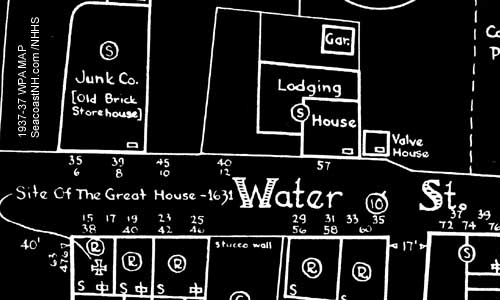|
FRESH STUFF DAILY |
|
|
||
|
|
||
|
|
||
|
SEE ALL SIGNED BOOKS by J. Dennis Robinson click here |
||
Page 1 of 3
The plan was to revive the crumbling Portsmouth, NH waterfront into a vibrant Maritime Village. The year was 1935. A famous architect and naval historian made a valiant attempt with a clever project – too clever, unfortunately, for Uncle Sam
READ ALSO: Who Started Strawbery Banke? The idea to turn the Portsmouth waterfront into an outdoor history museum did not start in 1957 with the founding of Strawbery Banke. Few people know that two decades earlier the federal government seriously considered converting the South End into a National Park. A recently rediscovered 1936 WPA blueprint shows detailed plans for a massive restoration project in what was then an ancient and dilapidated neighborhood along Marcy Street. The original plan, designed to create jobs during the Great Depression, called for restoring 175 old Portsmouth houses and moving or demolishing 75 "ugly new buildings".
The Portsmouth Maritime Village was the brainchild of two Kittery Point summer residents, architect John Mead Howells and naval historian Stephen Decatur. Both men came from famous families. Born in Portsmouth in 1886, Stephen Decatur IV was descended from a Revolutionary War hero whose son Stephen Decatur Jr. defeated the dreaded Barbary Pirates only to be killed by another naval officer in a duel. John Mean Howells was the son of William Dean Howells, an influential editor and writer and close friend of Mark Twain. The two influential men pitched their idea to the mayor of Portsmouth in 1934, but with little reaction. They then presented it to the National Park Service in 1935. Parks pitched it to the Works Progress Administration (WPA) under Franklin Roosevelt, the "New Deal" President.. Federal officials quickly agreed that Portsmouth was among the ten best sites in America for an outdoor history park. When Congress passed the Historic Sites Act in 1935, hope for the Howells-Decatur proposal blossomed. The Act summed up the very essence of the Portsmouth Project when it promised "to provide for the preservation of historic American sites, buildings, objects, and antiquities of national significance . . . for the inspiration and benefit of the American people." No other city in the nation, Decatur and Howells told the National Parks Department, could offer an intact waterfront neighborhood with buildings dating to 1695. First settled in 1631, Portsmouth’s Puddle Dock area could claim to be one of the oldest neighborhoods in America. But its peak as a major world shipping port ended in the early 1800s and the area had been in decline ever since. Howells and Decatur proposed to restore the entire waterfront area to the way it looked in 1800 when Portsmouth was in its heyday. Rather than tear down or modernize the decayed wharves and warehouses that still stood along the water, Decatur and Howells wanted to repair them. They also proposed to dredge out the Puddle Dock tidal inlet. (It was filled in early in the 20th century and is now a flat open area inside Strawbery Banke Museum.) When restored, the "Cove" would look as it had when the first Piscataqua settlers arrived from Europe. Local boat builders would then be hired, at government expense, to build four wooden boats, including a "barcantine" and a flat-bottomed gundalow, that would be docked in the restored cove. CONTINUE with WPA NATIONAL PARK
Please visit these SeacoastNH.com ad partners.
News about Portsmouth from Fosters.com |
| Saturday, April 20, 2024 |


|
Copyright ® 1996-2020 SeacoastNH.com. All rights reserved. Privacy Statement
Site maintained by ad-cetera graphics

 HISTORY
HISTORY




















